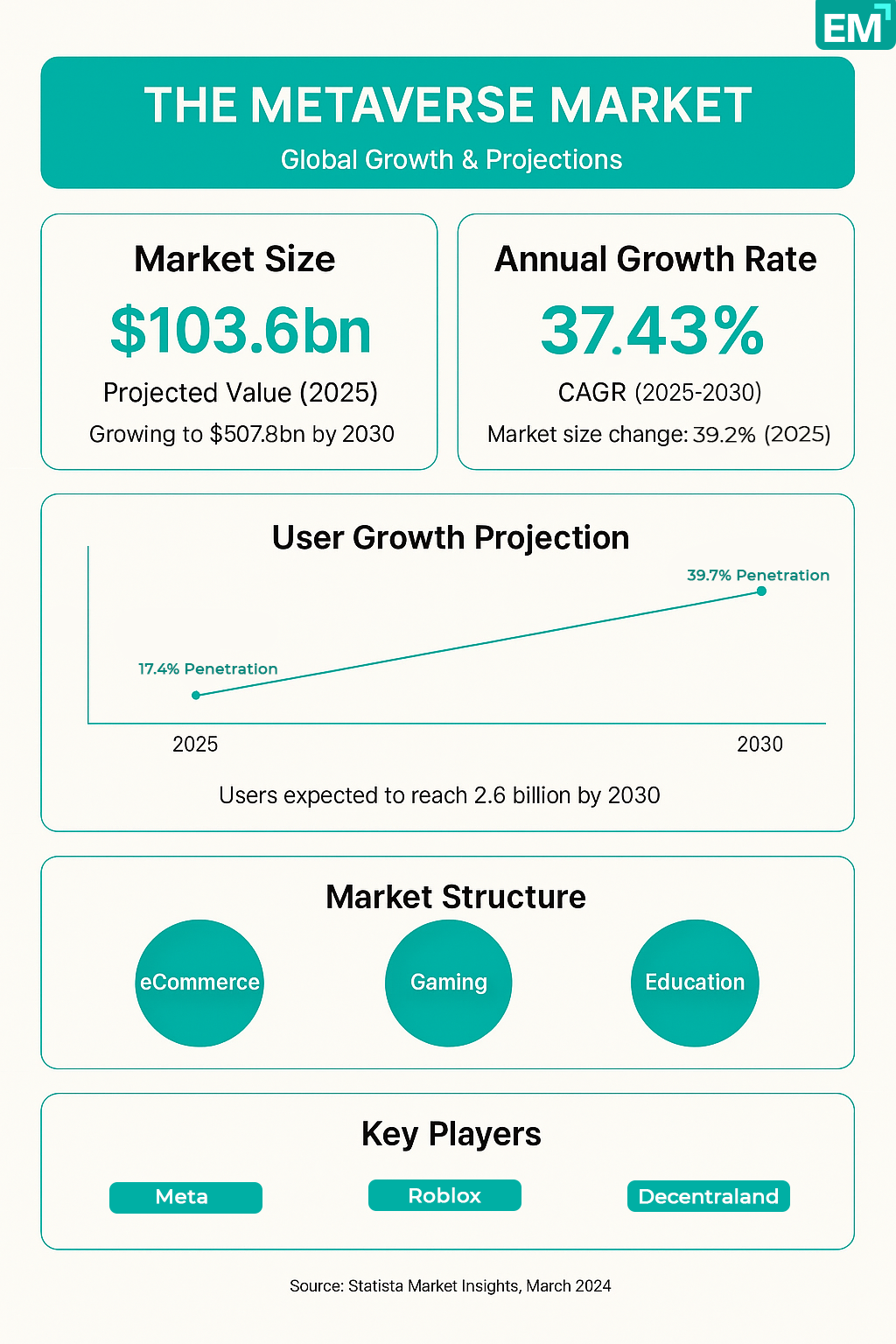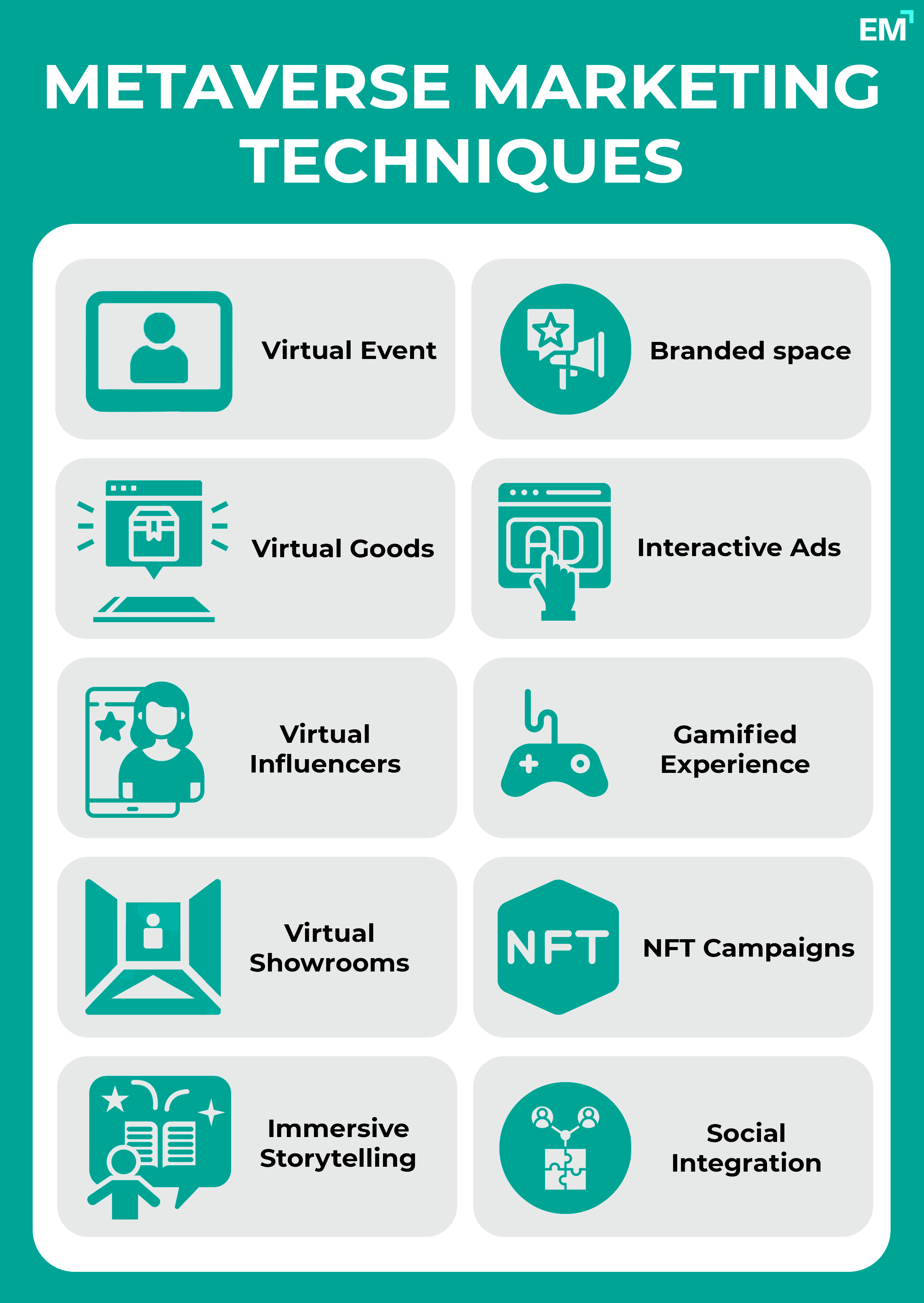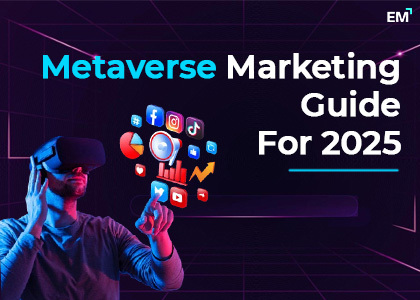In the past few years, Metaverse space has evolved from sci-fi concept to business reality, and we’re not just talking about it—we’re actively building, exploring, and marketing within it.
The Global Metaverse Market is estimated to reach a staggering $149 Billion in 2025 and is projected to explode to $4,462.5 Billion by 2034, registering an annual growth rate of 45.9% .
But what does this mean for the business, and how Metaverse Marketing Agency can help to grow? This guide explores how businesses can unleash creativity through virtual spaces and create immersive experiences for their customers through Metaverse Marketing Services. Read on to find out how businesses can connect with their target audiences and create memorable encounters through Marketing in Metaverse.
Ready to Elevate Your Brand in the Metaverse?
Are you ready to build the future of your brand in the metaverse?

So, What Is the Metaverse, Exactly?
Metaverse is a 3D, immersive digital universe where people interact with each other across multiple platforms. It’s not just VR headsets and gaming, it is a space where digital and physical realities converge, creating spaces where people can socialize, work, play, and yes, shop.
For example, Robolox, which started as a gaming platform has transformed into a virtual ecosystem where users attend concerts, hang out with friends, and purchase digital merchandise with real money.
The key to understanding the metaverse isn’t focusing on the technology—it’s recognizing the new behaviors and expectations it creates. People aren’t just passive consumers anymore; they’re active participants who expect immersive, interactive experiences from the brands they love.
Why Can’t Brands Afford to Miss Metaverse Marketing?
The traditional marketing channels are becoming increasingly saturated and expensive. TV ad effectiveness continues to decline. Social media algorithms make organic reach nearly impossible.
But the metaverse?
It’s still wide open territory with over 400 million monthly active users already engaged across various platforms.The opportunity isn’t just about reaching these users—it’s about connecting with them in entirely new ways.
Unlike passive advertising channels, the metaverse enables brands to create interactive, gamified experiences that deeply engage users.
For example: A business can partner with Metaverse Marketing Company for a product launch where every attendee can explore your new offerings hands-on, ask questions in real-time, and even make purchases—all without leaving their homes.
Industry leaders like McKinsey aren’t mincing words: by 2026, they project 25% of people will spend at least an hour daily in the metaverse. That’s not just a statistic—it’s a fundamental shift in how people spend their time and attention. The brands that establish themselves early will have an enormous competitive advantage.

Five Key Characteristics of Effective Metaverse Marketing
For promoting the product and services through Metaverse Marketing Services, business needs to focus on these 5 key characteristics:
- Immersive Storytelling, Not Advertising: The most successful metaverse marketing doesn’t feel like marketing at all. Brands like Nike aren’t creating virtual billboards—they’re building worlds where their brand values come to life through interactive narratives. Users don’t just see your message; they experience it firsthand.
- Community-Centric Approaches: The metaverse is inherently social. Effective marketing builds communities around shared experiences, not just products. When Gucci created its Garden experience in Roblox, it wasn’t just showcasing products—it was creating a gathering place for fashion enthusiasts to connect.
- Value Exchange Economics: In the metaverse, users expect something of value in exchange for their attention. This could be exclusive digital items, unique experiences, or real-world benefits. The transactional “I show you an ad, you buy my product” relationship is being replaced by more nuanced value exchanges.
- Seamless Physical-Digital Integration: The strongest metaverse strategies don’t exist in isolation—they connect virtual experiences to physical products and services. When someone tries on a virtual jacket in your metaverse store and then receives a discount to purchase the real thing, you’ve created a powerful cross-reality purchasing path.
- Experimentation and Adaptability: There’s no established playbook yet. The brands seeing the greatest success are adopting a test-and-learn mindset, moving quickly from failures, and doubling down on successes. If your metaverse marketing strategy isn’t evolving monthly, it’s already becoming obsolete.
Metaverse Marketing in Action: Five Popular Use-Cases
Theory is helpful, but seeing how brands are actually succeeding in the metaverse provides the most actionable insights. These five examples showcase different approaches to metaverse marketing that have delivered measurable results:
- Nike’s NIKELAND
Nike didn’t just create a virtual store in Roblox—they built an entire branded world where users can compete in games, collect virtual gear, and express themselves. What makes NIKELAND particularly effective is how it connects to physical retail: movement in Nike’s real-world stores can unlock features in the virtual world, creating a powerful cross-reality experience that drives both online engagement and in-store visits.
The results speak for themselves: Over 7 million visitors in the first few months and a measurable lift in Gen Z engagement with the brand. More importantly, Nike reports that NIKELAND has become a valuable product testing ground, with virtual item popularity helping predict physical product success.
- Gucci’s Virtual Fashion Show
When Gucci partnered with IMVU to create a virtual version of its Gucci Garden exhibition, many questioned whether luxury fashion could translate to digital spaces. The answer was a resounding yes. The virtual experience allowed visitors to explore elaborately designed rooms showcasing Gucci’s heritage and collections, with opportunities to purchase limited-edition virtual items.
What made this campaign remarkable wasn’t just the stunning visuals—it was how Gucci embraced the digital-native culture of the platform. Rather than simply recreating physical products, they created items that played with physics and reality in ways only possible in virtual worlds. One virtual Gucci bag even resold for more than the physical version costs in the real world.
- Volkswagen’s Interactive Test Drives
Volkswagen recognized a key problem in electric vehicle adoption: many potential customers have questions about range, charging, and the driving experience but aren’t ready to visit a dealership. Their solution was creating metaverse test drive experiences for their ID.4 electric SUV on Oculus Rift.
Users could not only see the car in 3D but customize features, test the vehicle in various virtual environments, and even simulate the charging process. The program resulted in a 60% increase in test drive requests and valuable data on which features potential customers spent the most time exploring.
- Adidas’ Virtual Stadium
Adidas’ approach centered on creating a virtual stadium where sports fans could gather to watch events, interact with sponsored athletes, and access limited-edition merchandise. Rather than focusing solely on products, Adidas created programming around major sporting events and exclusive athlete Q&As.
This community-first approach paid dividends beyond direct sales, with participants showing 32% higher brand affinity scores and significantly higher engagement with Adidas’ traditional marketing channels after participating in virtual events.
- Balenciaga x Fortnite
When luxury fashion house Balenciaga collaborated with Fortnite, they created more than just virtual outfits—they developed an entire branded in-game experience including a virtual Balenciaga store, unique game quests, and limited digital fashion items that players could purchase for their characters.
What set this collaboration apart was the bidirectional influence: the virtual designs influenced physical products, with Balenciaga producing real-world items inspired by the most popular in-game selections. This created a continuous feedback loop between virtual and physical design that has transformed how the brand approaches product development.
How To Integrate Metaverse into Your Marketing Strategy?
Here’s a practical roadmap that can help you with it:
- Start with Clear Objectives
Before diving in, define what success looks like. Are you aiming to increase brand awareness among younger demographics? Drive direct sales? Gather product feedback? Your objectives will determine which platforms and approaches make the most sense for your brand.
For example: if you’re focused on product education, a detailed virtual showroom on a platform like Spatial might be ideal. If you’re targeting Gen Z engagement, Roblox or Fortnite would likely be better fits.
- Know Your Platform Options
The “metaverse” isn’t a single place—it’s a collection of platforms with different audiences, capabilities, and cultures:
- Roblox: Offers the largest audience (particularly among under-18 users) and robust creator tools, but requires more gaming-oriented experiences.
- Decentraland: Attracts crypto-savvy users and offers true ownership of virtual land and assets through blockchain technology.
- Horizon Worlds (Meta): Provides the most immersive VR experience but requires users to own Quest headsets.
- Fortnite/Epic Games: Offers massive reach and high production values, though with less customization than other platforms.
- Minecraft: Has enormous reach across age groups but more limited visual fidelity.
Choosing the right platform means understanding where your target audience already spends time and which technical capabilities align with your marketing goals.
- Allocate Resources Appropriately
Building in the metaverse requires different skill sets than traditional marketing. Depending on your approach, you might need 3D designers, game developers, blockchain experts, or virtual event producers. Many brands find success by partnering with specialized metaverse marketing agencies or platform-specific studios rather than building these capabilities in-house.
A rule of thumb: start with 5-10% of your digital marketing budget allocated to metaverse initiatives, with the expectation of increasing this allocation based on performance.
Measure What Matters
Establish KPIs that align with your objectives. Typical metaverse metrics include:
- Time spent in branded experiences
- Number of virtual items acquired
- Social shares from metaverse experiences
- Cross-platform conversion (metaverse to website or store)
- Community growth and engagement
Traditional marketing metrics like CPM or CPC often don’t translate well to metaverse experiences—you’re building engagement and relationships, not just delivering impressions.
- Connect to Your Broader Marketing Ecosystem
The most effective metaverse strategies don’t exist in isolation. They connect to your overall marketing ecosystem:
- Email post-experience follow-ups
- Social media amplification of metaverse moments
- Physical product tie-ins with virtual experiences
- Customer data integration between metaverse and CRM systems
Creative Ideas for VR Marketing in the Metaverse
The leading marketing executives from the Forbes Agency Council recently shared innovative strategies for leveraging virtual reality in this emerging space.
- Retail Innovations
- Pop-Up Shops: Create temporary virtual showrooms with gamified elements to showcase products while educating consumers in an engaging way. This approach increases participation and creates positive brand associations.
- VIP Experiences: Transform physical products into digital keys by using RFID technology. When customers purchase real-world items, they unlock exclusive metaverse spaces with special offers and experiences, bridging physical and digital realms.
- Virtual Showrooms: Develop interactive 3D environments where customers can visualize products in personalized settings. From clothing to furniture, these spaces allow consumers to make more informed purchasing decisions through 360-degree views and customization options.
- Engagement Strategies
- Quest-Based Games: Implement treasure hunts and achievement systems that reward users for exploration and interaction. This approach increases platform “stickiness” and encourages repeated engagement with brand content.
- Virtual Treasure Hunts: Design gamified worlds where participants collect digital assets tied to real-world rewards, fostering deeper emotional connections with your brand while driving both virtual and physical engagement.
- Memory Palaces: Create explorable spaces representing your brand’s journey, values, and products. By incorporating puzzles and interactive elements, these environments make brand storytelling memorable through active discovery.

- Industry-Specific Applications
- Healthcare Hubs: Develop virtual centers where patients explore 3D models of medical conditions, participate in wellness workshops, and attend consultations. This educational approach builds trust while demonstrating advanced capabilities.
- Fashion Runways: Host virtual fashion shows where users try on digital outfits and purchase real versions, creating a seamless path from virtual exploration to physical sales.
- Automotive Customization: Build immersive showrooms where customers design dream vehicles from scratch and test drive them on virtual tracks that adapt to each car’s specifications, revolutionizing the car-buying experience.
- Marketing Workshops: Showcase your marketing strategies through interactive virtual spaces with live demonstrations and Q&A sessions, allowing potential clients to engage directly with your services.
- Emerging Trends
- Virtual Influencer Collaborations: Partner with digital personalities for challenges that generate user-created content, or enable direct interaction between influencers and consumers through VR experiences.
- Humor-Driven Experiences: Create whimsical, unrealistic environments that entertain while subtly promoting services—even for serious industries like legal services, where playful approaches can be surprisingly effective.
- Live Entertainment: Host virtual concerts, game shows, and giveaways to entertain your target audience while providing interactive brand touchpoints. These time-sensitive events create urgency and excitement.
- Metaverse Influencer Sponsorships: Prepare for the emerging trend of people uploading digital versions of themselves into virtual spaces. Forward-thinking brands should position themselves to quickly leverage these new promotional opportunities.
The metaverse represents a transformative marketing frontier where creativity is the only limitation. For brands seeking competitive advantage, the time to establish presence in these virtual worlds isn’t next year—it’s now.
The Future of Marketing: What’s Coming Next?
As we look forward, several trends are emerging that will shape the next evolution of metaverse marketing:
- Spatial Commerce
The lines between e-commerce and metaverse shopping will continue to blur. Brands will create persistent virtual stores that serve as both marketing vehicles and direct sales channels. Companies like Shopify are already enabling merchants to sell physical products through virtual showrooms.
- Cross-Platform Identities
Currently, most metaverse platforms operate as separate islands. Soon, users will expect to carry their digital identities—including avatars, possessions, and brand relationships—across platforms. Smart marketers are already thinking about how their metaverse presence will function in this more interoperable future.
- AI-Driven Personalization
As AI continues to advance, metaverse experiences will become increasingly personalized. Virtual brand representatives will remember individual customers, their preferences, and their history with the brand, creating tailored experiences that would be impossible to scale with human representatives.
- Augmented Reality Integration
The metaverse won’t be limited to fully virtual worlds. Augmented reality will bring metaverse elements into physical spaces, creating new marketing opportunities that blend digital and physical realities. Imagine walking down a real street and seeing personalized brand experiences overlaid on your surroundings.
Getting Started: Your First 90 Days in Metaverse Marketing
If you’re ready to take the plunge, here’s a practical 90-day roadmap to establish your brand in the metaverse:
Days 1-30: Research and Planning
- Identify which platforms your target audience already uses
- Analyze competitors’ metaverse presence
- Define clear objectives and KPIs
- Determine budget and resource requirements
Days 31-60: Build and Test
- Partner with Metaverse Marketing Agency for execution.
- Create a minimum viable presence on your chosen platform
- Test with a small user group
- Gather feedback and refine
Days 61-90: Launch and Optimize
- Full public launch of your metaverse experience
- Promote across traditional marketing channels
- Collect user data and analyze performance
- Identify optimization opportunities
The Time for Metaverse Marketing Is Now
The metaverse isn’t some distant future—it’s here today, growing rapidly, and creating unprecedented opportunities for innovative marketers. With projected growth from $149 Billion in 2025 to over $4.4 Trillion by 2034, this isn’t a space any forward-thinking brand can afford to ignore.
The brands that establish themselves now will have insurmountable advantages as the metaverse continues to expand. They’ll have the data, the relationships, and the institutional knowledge that latecomers will struggle to develop.
Start small, learn continuously, and scale what works. Metaverse marketing rewards experimentation and authenticity more than perfection.
Emergence Media: Your Metaverse Marketing Partner
At Emergence Media, we don’t just market in the Metaverse—we help brands thrive in it. As a leading Metaverse marketing firm, we create immersive campaigns that build real connections, spark engagement, and drive growth in virtual spaces.
Let’s Connect With Us!
Let’s build something extraordinary together. Partner with Emergence Media and shape the future of marketing! Ready to make your mark?

